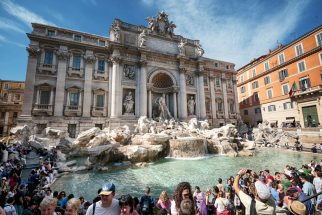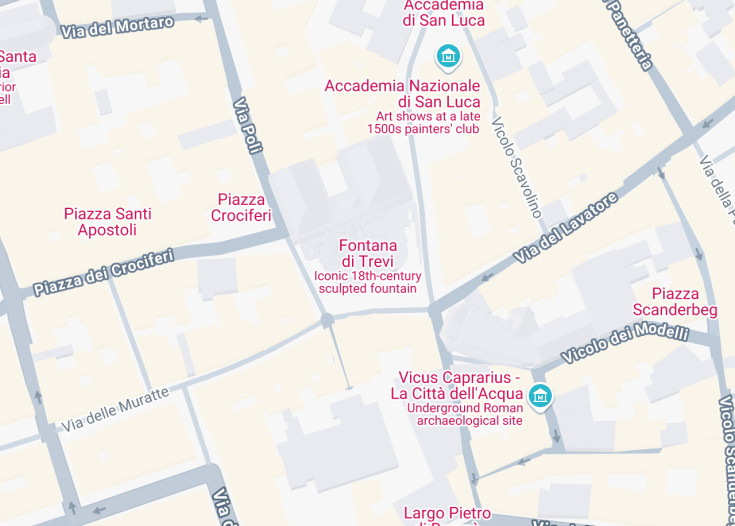The Trevi fountain is probably the most famous fountain in the world and it is certainly the largest and most spectacular of the approximately 50 monumental fountains that adorn the streets and squares of Rome. Tourists love to continue the time-honoured custom of throwing a coin into its waters to ensure their return to the Eternal City.
When you visit the Trevi fountain be sure to toss a coin into its waters. Please don’t be tempted to follow in the footsteps of Anita Ekberg and Marcello Mastroianni in the film “La Dolce Vita”, by walking or swimming in the fountain, or you may face a 500 euro fine. Times have changed a lot since 1960!
The waters of the Trevi fountain are usually flowing, but sometimes they are turned off in the early morning for maintenance work. To avoid any disappointment you should visit the fountain after 9am, or in the evening when it is illuminated to further enhance its romantic and scenographic appeal.
Trevi Fountain: A Masterpiece of Baroque Art
The Trevi Fountain, located in the heart of Rome, Italy, is an iconic symbol of the city and one of the largest and most famous fountains in the world. Completed in 1762, this stunning example of Baroque architecture attracts millions of visitors each year who come to admire its intricate sculptures and cascading waters. Legend has it that tossing a coin into the fountain guarantees your return to the Eternal City. The fountain features a magnificent central statue of Neptune, flanked by allegorical figures that represent Abundance and Health. The sound of rushing water and the grandeur of the surrounding architecture create a captivating ambiance that enchants tourists and locals alike. By visiting the Trevi Fountain, you not only experience its visual beauty but also partake in a long-standing tradition that connects you to the history and culture of Rome.
Activities to Enjoy at Trevi Fountain
While visiting Trevi Fountain, there are several attractions and activities that enhance the experience. The surrounding area is bustling with street performers, creating a lively atmosphere for visitors. You can enjoy the delightful experience of capturing the perfect photo in front of this magnificent structure. Additionally, nearby cafes and gelato shops invite you to indulge in delicious Italian treats as you take in the scenery.
Evening Visits
Visiting the Trevi Fountain in the evening presents a different perspective, as the fountain is beautifully illuminated, enhancing its magical charm.
A Unique Tradition: The Coin Toss
One of the most famous traditions associated with the Trevi Fountain is the act of tossing a coin over your shoulder into its waters. This charming ritual stems from an ancient belief that doing so ensures your return to Rome. The coins collected in the fountain are regularly removed and donated to charity, assisting those in need. This practice not only adds an element of fun for tourists but also contributes positively to the local community, making the Trevi Fountain a place of both hope and generosity.
Fall in Love with the Enchantment of the Trevi Fountain in Rome, Italy
The Trevi Fountain, an exquisite masterpiece of Baroque art, captures the imagination of every visitor. This enchanting fountain is not only an aesthetic delight but also rich in legend and history. As you approach, the sound of cascading water creates a mesmerizing ambiance that draws people in like a magnet.
Designed by Nicola Salvi in the mid-18th century, the fountain features a stunning statue of Neptune, flanked by his chariots, symbolizing the sea’s bounty. The intricate sculptures and the vibrant water create an atmosphere of romance and wonder, making it a perfect spot for couples, families, and solo travelers alike.
Visitors can expect to take part in the famous tradition of tossing a coin over their left shoulder, ensuring a return to Rome. This simple act connects tourists to the allure of the fountain, deepening their experience. Additionally, sitting near the fountain allows guests to absorb the beauty of its design, bestondering its details while enjoying a gelato from one of the nearby vendors.
The Trevi Fountain is an essential part of any Roman itinerary. It pairs beautifully with other attractions like the Pantheon and the Spanish Steps, forming a perfect walking route through the city’s historical heart. Often less crowded in the early morning or late evening, this magical site offers an intimate experience.
For a unique visit, consider joining a guided tour that reveals the fountain’s secrets, along with its debate-inducing artistic styles. A local guide can share fascinating anecdotes which truly enrich your understanding and appreciation of this iconic landmark.
Discover the Best Time to Visit the Trevi Fountain in Rome, Italy
When planning your visit to the Trevi Fountain, timing is crucial. The best times to experience the fountain are during the early morning hours or later in the evening. These periods not only attract fewer crowds but also offer stunning lighting for photography, enhancing the overall charm of the fountain.
Special Events
One cannot miss the Feast of the Immaculate Conception on December 8th, when the fountain is adorned with flowers, creating a breathtaking sight. This annual celebration provides a unique opportunity to witness the Trevi Fountain amidst festive decorations, making it an ideal time to visit.
Understanding Accessibility and Limitations at the Trevi Fountain
While the Trevi Fountain is an accessible tourist attraction, it’s essential to be aware of certain limitations that could impact your visit. Due to its popularity, the area can become quite crowded, especially during peak times.
Accessibility
Limitations
- Strict restrictions on climbing the fountain’s edges or statues.
- No swimming or wading in the fountain.
- Feeding pigeons or other wildlife is discouraged.
- Unattended bags can be removed to ensure safety.
Notes to visitors
- Respecting social distancing guidelines in busy areas.
- Photography is permitted, but professional photographers may require a permit.
- Evenings can see some restrictions during special events or maintenance.
General Information
Details for your visit to the Trevi Fountain
Location
The Trevi Fountain is centrally located near other famous Roman landmarks, including the Pantheon and the Spanish Steps. It is easily reachable on foot from various urban points of interest.
Visiting Information
The Trevi Fountain is open to the public year-round, 24/7. There are no strict closing hours, allowing visitors to soak in its beauty at any time. For a truly optimal experience, visiting in the early morning or late at night is recommended when the atmosphere is peaceful, and the fountain is beautifully illuminated.
How to Reach the Trevi Fountain
Car
The Trevi Fountain can be easily reached by car, but parking options are limited. It’s recommended to use public transport or park in designated areas further from the fountain and walk.
| Route | Distance | Travel time |
|---|---|---|
| From Rome Termini Station | 1.5 miles (2.4 Km) | 10 minutes |
| From Piazza Navona | 0.6 miles (1 km) | 8 minutes |
| From Vatican City | 2.2 miles (3.5 Km) | 15 minutes |
Public Transport
The fountain is easily accessible by several bus lines that run through the city. Look for buses heading to the Trevi stop, which is just a short walk away.
| Route | Distance | Travel time |
|---|---|---|
| From Rome Termini Station | 1.5 miles (2.4 Km) | 15 minutes |
| From Piazza Navona | 0.5 miles (0.8 km) | 5 minutes |
Nearby Attractions
- Spanish Steps – 0.5 miles (0.8 km)
- Pantheon – 0.6 miles (1 km)
- Piazza Navona – 0.7 miles (1.1 km)
- Palazzo Barberini – 0.8 miles (1.3 km)
- Quirinal Palace – 1 mile (1.6 km)
- Villa Medici – 1.1 miles (1.8 km)
- Roman Forum – 1.2 miles (1.9 km)
- Colosseum – 1.5 miles (2.4 km)
- Galleria Borghese – 1.7 miles (2.7 km)
- Castel Sant’Angelo – 1.8 miles (2.9 km)
- Trastevere – 2.2 miles (3.5 km)
- Vatican City – 2.4 miles (3.9 km)
Common Questions
What is the history behind the Trevi Fountain?
The Trevi Fountain, or “Fontana di Trevi,” has a rich history that dates back to ancient Roman times. It was originally part of the Aqua Virgo aqueduct, which was built in 19 BC to supply water to the Roman baths. The aqueduct was a significant engineering achievement of its time and was vital to the city’s infrastructure, providing a steady supply of fresh water.
As the centuries passed, the aqueduct fell into disrepair until Pope Urban VIII commissioned the redesign of the fountain in the 17th century. The current Baroque-style fountain was officially completed in 1762, featuring a dramatic combination of water, statues, and architecture designed by Nicola Salvi. Notably, the fountain depicts Oceanus, the god of the sea, flanked by allegorical figures representing abundance and health.
Today, the Trevi Fountain stands not only as a masterpiece of Baroque art but also as a symbol of prosperity and good fortune. The tradition of tossing coins into the fountain—over 3,000 euros worth daily—is believed to ensure a return to Rome for visitors, further embedding this iconic landmark within the city’s rich cultural tapestry.
What do the sculptures of the Trevi Fountain represent?
The sculptures adorning the Trevi Fountain are rich in symbolism and artistic expression, capturing the grandeur of the Baroque art movement. Central to the fountain is the towering figure of Oceanus, the Greek god of the sea, representing the importance of water in the lives of ancient Romans.
Oceanus is depicted riding a chariot shaped like a shell, pulled by two sea horses that symbolize the dual nature of the sea—one horse is calm while the other is wild, signifying the varying moods of water. Accompanying Oceanus are two allegorical figures: Abundance, who holds a cornucopia spilling coins, and Health, who is shown with a staff entwined with a serpent.
These sculptures reflect the prosperity that the aqueduct brought to the city while also paying homage to Roman mythology. The intricate details of the fountain, combined with the flowing water, create a dynamic tableau that expresses both the beauty and power of nature. The Trevi Fountain serves as a constant reminder of Rome’s historical relationship with water and its capacity for life.
What is the legend associated with the Trevi Fountain?
The Trevi Fountain is steeped in legend, particularly surrounding the tradition of coin tossing. One of the most popular tales is that tossing a coin over your left shoulder into the fountain guarantees your return to Rome someday. This practice is rooted in the belief that the Trevi Fountain stands as a bridge between the earthly realm and the spirit of the city.
According to folklore, the origins of this custom can be traced back to ancient Romans who believed that by throwing coins into the fountain, they were showing respect to the water gods, ensuring a safe journey home. It is estimated that over 3,000 euros are thrown into the fountain each day, with the money typically collected by the local authorities to fund charitable causes.
Another legend suggests that if you toss a second coin, you’ll find love in Rome, while a third coin will lead to marriage. These whimsical beliefs add a layer of enchantment to the visit and highlight the fountain’s role as a cultural landmark. The ritual of coin tossing connects both visitors and locals to the enduring spirit and mythology of Rome.
How has the Trevi Fountain been featured in films and pop culture?
The Trevi Fountain has become a global icon and a beloved backdrop for numerous films and television shows, celebrating romantic and adventurous moments in various narratives. Its most famous cinematic appearance is in Federico Fellini’s classic film “La Dolce Vita,” released in 1960. The scene depicting actress Anita Ekberg wading through the fountain’s waters became visually iconic and solidified the fountain’s status in popular culture.
Since then, the Trevi Fountain has been featured in a variety of other films, including “Three Coins in the Fountain,” and “Roman Holiday,” where the romantic atmosphere of the location added to the overall charm of these cinematic tales.
The allure of the Trevi Fountain extends beyond the silver screen; it has inspired countless artists, musicians, and authors through the years, capturing not only the essence of Rome but also the emotions of love and nostalgia. As a result, the fountain remains a must-visit location for fans of film and art alike, offering a glimpse into the cultural significance of this monumental site.
What are the best times to visit the Trevi Fountain?
Visiting the Trevi Fountain is a magical experience, but to make the most of your visit, timing can be key. The fountain is most enchanting in the early morning, around dawn, when the soft light creates a serene atmosphere. This time allows you to appreciate the fountain without the crowds that typically gather later in the day.
Another optimal time is during the late evening after the sun sets. The Trevi Fountain is beautifully illuminated at night, casting a shimmering reflection in the water and creating a romantic ambiance. The cooler temperatures and decreased foot traffic also make for a more enjoyable experience.
It’s wise to avoid peak tourist seasons like the summer months and weekends if possible. If you do visit during busier times, try to arrive early in the morning or later in the evening. Regardless of when you choose to visit, the Trevi Fountain is sure to leave a lasting impression, but careful timing can enhance your experience even further.

Is the Trevi Fountain in Rome Worth Visiting?
The Trevi Fountain is undeniably one of Rome’s most iconic attractions, captivating visitors with its stunning Baroque architecture and intricate sculptures. Many tourists flock to see it, drawn by the stories of tossing coins to ensure a return to the city. This tradition adds a sense of magic and excitement to the visit. However, it’s important to note that the fountain can become quite overcrowded, especially during peak tourist seasons, making it challenging to fully appreciate its beauty.
Despite the crowds, the aesthetic appeal and the accompanying legends make the Trevi Fountain a must-see for many. For those seeking the best experience, visiting early in the morning or later in the evening can provide a more intimate atmosphere.










